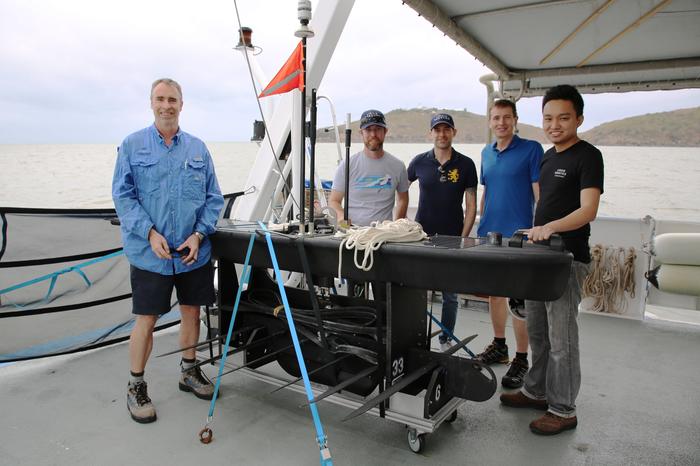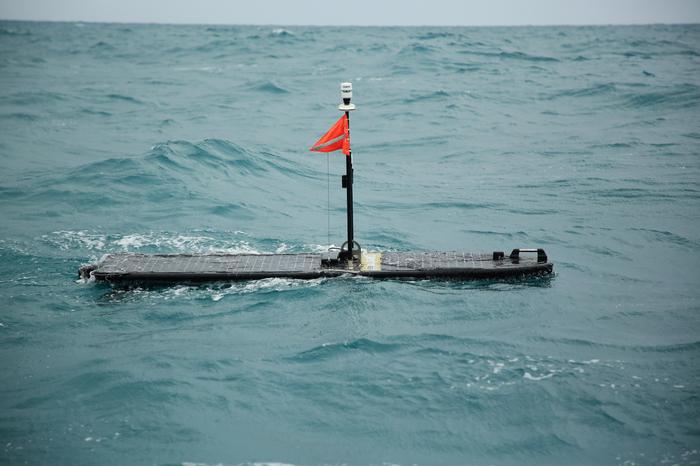The surfing robot helping to save the Great Barrier Reef
- 12 October, 2017 11:19

An autonomous floating robot packed with sensors has been deployed to monitor the waters surrounding the Great Barrier Reef.
The vehicle – called the Wave Glider – recently completed a seven-day, 200 nautical mile trial voyage of the central reef, to collect data for the Australian Institute of Marine Science (AIMS).
The test expedition saw the vessel collect a range of meteorological and oceanographic data and relay it back to shore in real-time.
“We’re trying to observe something that’s 350,000 square kilometres in area – and up to 60 metres deep. That’s an interesting challenge,” AIMS’ head of data and technology innovation, Dr Lyndon Llewelyn told Computerworld.
“So we’re trying to modernise how we observe things, and technologies that operate robustly and routinely in marine environments are not common. This is one that has been emerging and is probably one of the most mature. It will be an important tool to advance our mission to better monitor the Great Barrier Reef,” he added.
The craft is made up of two parts, a three-metre surfboard covered in solar panels which carries the sensors and instruments, and a wave-powered underwater section on an eight-metre ‘umbilical cord’ that pulls it along.
Aboard the bot for the initial trial was a mini-weather station; an acoustic Doppler current profiler (“to measure ocean currents through the water columns so you know what the water is doing at different depths,” Llewelyn explained); wave monitors to measure wave climate; and instruments to measure water temperature, pressure, salinity and cleanliness.
The chlorophyll content of the water (a measure of the plankton in the water) and the amount of hydrocarbons (an indicator of oil spills and leaks) were also recorded.
The data was beamed back to AIMS’ labs near Townsville via Telstra’s data network, and over Wi-Fi when in range.

Bye buoys
The bot and ones like it could potentially replace the need for scientific instruments to be permanently buoyed offshore, which require maintenance and recharging.
“We moor instruments at sea and that data is beamed in to us from a surface buoy or we go and collect it. So every six to nine months we need to send our ships out and service them because the batteries run down and you get failing and things like that. That’s quite a complex operation,” Llewelyn said.
“So instead of doing that you tell this boat – go to that spot where we want to have a mooring and swim around in a circle. We can then have our ships and people doing other tasks rather than just servicing instruments.”
Multiple Wave Gliders could be deployed to work in tag-teams, surfing out to replace others that need to return to shore for maintenance, so a location has an unbroken data stream.

“The demonstration proves how autonomous systems like our Wave Glider can improve upon human-based environmental data collection methods while also being safe and affordable," said Boeing Autonomous Systems vice president and general manager Chris Raymond.
Page Break
The Wave Glider has been used for similar missions elsewhere in the world. Since last year, the UK’s Foreign and Commonwealth Office has used one to police an 840,000 square kilometers of remote marine habitat surrounding its remote Pitcairn Islands territory in the Pacific Ocean.
The craft there is equipped with a camera that can photograph fishing vessels passing restricted areas, and is able to pinpoint their location.
They have also been used in military and commercial settings. Chevron has used the autonomous vessel around its operation off the coast of north west Australia to measure turbidity and demonstrate environmental compliance.
Seabed to space
The surfing robot is the first of a number of technologies being put to work on the reef by AIMS, the result of a five-year joint research agreement with aerospace giant Boeing. The vessel is made by Boeing subsidiary Liquid Robotics.
AIMS and Boeing are now planning to trial other technologies, which will help monitor the reef “from the seabed to space” Llewelyn said.
“Wave Glider is just one element. It provides us with the surface element. [Boeing] have got extraordinary capability in terms of satellites, aerial drones, autonomous underwater vessels,” he explained.
“The thing for us is, it’s got to be something that can provide routine, robust data. It’s one thing for someone to go out and look at something once – we need to go there again and again and again. That’s one of the challenges and there’s a very rich landscape of new technologies coming out. So it’s a process of identifying those things with potential,” Llewelyn said.
Work has already begun – with Boeing company Insitu Pacific – to investigate the use of medium-range unmanned aerial systems equipped with hyperspectral cameras to collect high-quality imagery for seabed habitat mapping, modelling and classification, reef monitoring, and potentially 3-D reef reconstructions.
Much of the collected data will go towards validating eReefs, a six-year $30 million project begun in 2012 that measures and models the conditions on the Great Barrier Reef.
“That can then be used for forecasting and looking at different scenarios, trying to understand the phenomena we see,” Llewelyn explained.
“We’ve had two big bleaching events and one of the big drivers for that is sea water temperature. So understanding how sea water temperature behaves and what is happening out there allows us to recommend and design ways of dealing with it. And it might seem small, but understanding how the water moves, where, when and why – there’s still a lot to learn in that space in the Great Barrier Reef,” he added.
